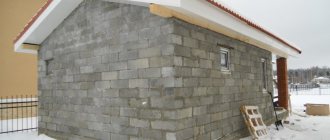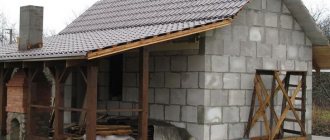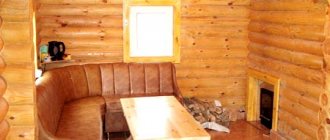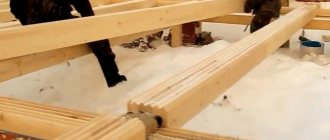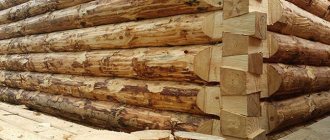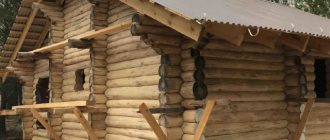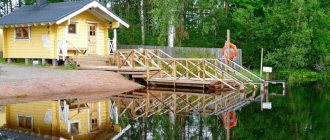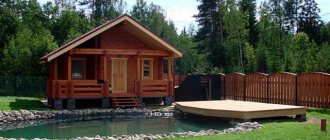Even on a small plot, the owner wants to have a house and a building for couples’ procedures. This is quite possible if you build a mini-bath. The compact structure can be easily placed even on a tiny plot of land. A competent approach to its design allows you to get an object that will become a real decoration of the territory. The materials for its construction are available to most, and the process itself is not particularly complicated. This allows you to arrange such a structure on the site without the help of specialists.
A mini sauna on your site will allow you to spend time with health benefits
Features and advantages of small bath buildings
For a summer house, you can build a small wooden bathhouse.
The most popular material for building a bathhouse is wood, which is highly flammable. This imposes a number of fire safety restrictions: the need for treatment with fire retardant compounds, strict adherence to fire safety standards when installing the stove and chimney. When building any bathhouse, even when using non-combustible material, it is necessary to maintain the regulated distance to neighboring objects located on the site.
Construction of a steam room is a fairly simple and quick procedure. In most cases, small baths for a summer residence do not require a solid foundation and the purchase of a large volume of raw materials. In addition, in the process you can use up timber and other available materials left over from the construction of other structures.
The raw materials used should not have rotten areas, wormholes, cracks or other signs of destruction.
Other advantages include:
- no need to spend money on a massive foundation;
- speed of construction;
- small area occupied by the object, which is especially advantageous if the site is small;
- the ability to fit the building into different types of landscapes due to its compactness.
Wall installation
Building the walls of a mini-bath becomes a simpler task if the owner has opted for a frame-type structure. Such an object for paired procedures is easier to construct. The inside of a frame made of wood must be sheathed with timber.
The outside of the building is decorated with a block house. This solution allows you to provide a spectacular look for a compact building. You can also choose a finishing option that matches the design of the garden house. When selecting materials, special attention should be paid to their fireproof properties.
Stage two - selection of materials
In general, bathhouses are usually made from various building materials - bricks, blocks and even sandwich panels. But the best option is a tree and here's why:
Bathhouse built using frame technology
When constructing a bathhouse, the environmental cleanliness of the constituent elements plays a special role. It's all about the high temperature, due to which building materials that are harmless under normal conditions begin to release compounds that negatively affect the health of those washing. Therefore, it is extremely undesirable to use any artificial insulation - mineral wool and polymers - in a bath house. What to use:
- dried timber with a section of 15 x 15 or 10 x 15 cm;
- edged boards 150 x 50 or 150 x 40 mm;
- finishing lining;
- materials for caulking – jute, moss, flax;
- natural insulation materials - expanded clay, sawdust, clay and so on.
Log bathhouse
A few words about how best to build a bathhouse from lumber, or more precisely, about the design of the walls. There are 3 methods to choose from:
- Installation using frame technology.
- Prefabricated timber structure.
- Walls made of logs (log house).
The preferred option is a bathhouse built with your own hands from timber, shown in the photo below. It meets all the requirements and is relatively inexpensive. Yes, a frame building is cheaper, but it uses basalt wool for insulation, which releases carcinogenic substances when heated. A log house is environmentally friendly, but requires a strip foundation, and this increases the cost of the project. In addition, the logs must be able to be connected correctly to make the structure beautiful and warm.
Roof
There are two options: gable or single slope. For a bathhouse measuring 3x3, you can use the simplest option - a lean-to slope.
Installation of pitched roofs
If you choose this option, then you need to do the ceiling right away. For a bathhouse, it must be insulated; you can choose mineral wool (much more expensive and more complex) or polystyrene foam (cheaper and faster). Let's focus on a simple option - foam insulation. It is not afraid of moisture, and there is no need to use various steam and water barriers.
Foam insulation
Characteristics of foam plastic
Prices for foam insulation
PSB foam insulation
Insulation needs to be installed in several stages:
- nail edged boards to the ceiling beams from below, 20 mm thick is sufficient;
- lay foam boards on them. Place them as tightly as possible, avoid gaps. Polystyrene foam can be cut perfectly with a special carpenter's knife under a ruler. During the marking period, provide dimensions 1÷1.5 cm larger - the foam will shrink during installation, the insulation will become airtight;
- Lay any boards on top of the beams, these can be various sections, slabs, etc. The main requirement for them is to withstand the weight of people during the installation of the roof. Once the roofing work is completed, no one will walk on the roof anymore.
Ceiling insulation with foam plastic
If the roof is gable, then make a temporary ceiling, and insulation can be done later. Is everything ready? Great, let's build a roof.
| №№ | Illustration | Description and explanations |
| Step 1. | Check the vertical position and dimensions of the top crown. The dimensions are normal - excellent, there are significant horizontal deviations - no problem, we will level the horizontality with rafters. | |
| Step 2. | Determine the angle of inclination of the slope. We recommend an inclination angle of approximately 20°. Another important point is which direction the rainwater will flow, take into account the features of the site, the location of the entrance doors and the features of existing buildings. | |
| Step 3. | Place a stop for the rafters at the calculated height. It’s simple to do - install vertical supports from beams of a given height, place a horizontal beam on them. The distance between the supports is approximately 1.5 meters. The structure can be assembled without cuts; it is enough to use metal corners and self-tapping screws. In order for the stop to withstand angular forces, secure it with corner boards to the floor beams. | |
| Step 4. | Measure the length of the rafters taking into account the overhang. For our case, 3.2 meters is enough. For rafters, use 50x100 mm boards; for a 3x3 meter bathhouse, 6 pieces are enough. | |
| Step 5. | Install the outer rafters, stretch a rope between them and lay all the rest along it. To secure it to the beams, it’s safer to make notches; if you don’t have the desire or skill, use metal corners. | |
| Step 6. | Ondulin | For the roofing we chose ondulin - one of the cheapest and fairly high-quality materials. You should not use various advertised hydrobarriers. Firstly, if you install the roofing material correctly, there will be no leaks. Secondly, if they exist, then no barriers will help: they will sag under the weight of the water and tear over time. |
| Step 7 | Lathing. Ondulin is in many ways similar to ordinary asbestos slate, the difference is that it has less physical characteristics in terms of the perception of vertical forces. This means that the sheathing should be laid more often; each sheet of ondulin should rest on four slats. The distance between the slats is 35÷40 cm. Instead of slats, you can use narrow unedged boards; they are almost the same in cost, but when nailing ondulin, there is less chance that the nail will “go nowhere.” | |
| Step 8 | Ondulin fastening | Carefully align the first row, do not rush the sheets to arrive immediately; for beginners, it is advisable to lay out the entire row and check its position, and only then pick up a hammer and nails. Ondulin can be fastened with ordinary slate nails; fixation is carried out in the upper wave. The lower the slope angle, the greater the overlap of sheets should be. In our case, the sheets should overlap by about ten centimeters. Be careful not to overdo it with driving force, so as not to damage the wave. If you wish, install a drainage system. |
| Step 9 | Fill up the spaces between the rafters and the wall of the bathhouse on the side of the elevation of the slope with boards, install wind boards. |
That's it, urgent work is done, the log house can be left for the winter. During this time, the bathhouse will shrink and the relative humidity will stabilize to natural values. If you want to wash faster in your own bathhouse, continue construction work.
Insulation options
When creating a mini-bath, one of the important points is its high-quality insulation. Before doing this work, it is necessary to eliminate all the cracks that are present in the walls. When installing a layer of thermal insulation, it is optimal that its thickness be at least 15 cm. In regions with harsh climatic conditions, this figure can be increased to 25 cm. The process of laying the material occurs staggered. This technique allows you to completely eliminate the appearance of cold bridges. If they are present, the heat will quickly leave the bath. This cannot be allowed.
To create a layer of thermal insulation, you can use a variety of materials:
- mineral wool;
- sawdust with clay;
- expanded clay
If you need an inexpensive solution with high performance, then you can hardly find anything better than polystyrene foam. Many are skeptical about its use in the bathhouse. But it still provides good thermal insulation performance. A 12 cm thick layer of insulation based on it is enough to replace an 80 cm layer of mineral wool. This material can operate effectively in the temperature range from -100 to + 80 ° C.
Floor
The foundation in our project rises 20 cm above the surface, so you can proceed as follows:
- We compact the soil well and lay a hydraulic barrier.
- We fill the space with expanded clay on top.
- We lay joists for the future floor.
- We place mineral wool in the space between the joists. To prevent its parts from knocking out, you can also lay a film on top.
- The floor is sewn up using boards that are laid closely.
- There is another method. You can screw the sheathing to the beams that were used for the bottom trim using metal corners, lay film or other waterproofing on it, and lay mineral wool or foam plastic on top. Next, everything is sewn up with a board and you get a warm floor.
- Do not forget that in the steam room it will be necessary to make a certain slope, thanks to which the water will flow into the installed drain.
Note! In regions where the temperature in winter does not drop too low, the floor is practically not insulated. And the space under the steam room is filled with concrete and a slope is made so that the water drains through the floor onto the slope and then falls into the cesspool.
What do you need for a bath?
The most necessary component of a sauna holiday is a stove. There are a huge number of mini sauna stoves on the market. But if you have welding skills and an inverter, you can weld a stove yourself.
Stove in a barrel
Typically, mini-ovens for small volumes are metal structures designed to generate steam. As an example, consider the Varvara “Mini” sauna stove.
Wood-burning stove Varvara Mini with a water circuit for a saunaSauna stove Varvara Kamenka mini
This is a wood-burning stove with overall dimensions of 48x66 cm and a height of 88 cm. The steel structure of the firebox itself is covered on top with a casing, inside of which there are convection channels. The air, heating up in the firebox area, escapes into the heater through the holes in the casing, thereby quickly heating the stones. As a result, the oven heats up very quickly, warming up a small room in a very short time.
In addition, there are also simpler stove designs in which the heater is heated directly by exposure to heat from fuel combustion. When using a mini-stove for a wood-burning sauna in a steam room, you need to provide a place for storing fuel, a woodpile or a shed not far from the sauna.
For small steam rooms, in some cases it is advisable to use electric sauna stoves and electric heaters.
Kamenka
Mini-pools for baths
Additional installation of a swimming pool in the sauna will expand the functionality of the sauna and add comfort. It is worth noting that it is better to initially provide for the installation of a swimming pool in the bathhouse design, since mini-pools for a bathhouse require water supply systems, water drainage, and heating.
Pool
For this reason, embedding a pool into a finished bathhouse is quite troublesome and costly. There are several types of pools designed for installation in a bathhouse:
- Stationary. In this case, the pool is initially included in the bathhouse design, a pit is dug under it, the walls of the pool are concreted and covered with a decorative coating. This type of pool is used mainly for full-size bath buildings.
- Font. A metal or plastic structure designed for installation in a pre-prepared bed. To put it into operation, you only need to connect the font to the water supply system.
- Portable pools. Metal structures with plastic trim. Just like a font, they are installed in a prepared bed, after which they are connected to the water supply system.
Swimming pools can be equipped with water heating systems and hydromassage equipment, but in this case, connecting them requires the help of qualified specialists.
Mini sauna for a summer residence
A sauna is distinguished from a bathhouse by the type of steam and temperature. In order to make a sauna out of a steam room, it is enough to install an electric steam generator, an electric heater or a wood-burning sauna boiler inside the steam room. When using a steam room for a sauna, it is recommended that the interior be made from one type of wood: pine, linden or alder. A mini-sauna in a country house should be as closed as possible, practically airtight
Particular attention should be paid to its thermal insulation. This is necessary to maintain a high temperature inside the sauna for a long time, with minimal energy consumption
Mini sauna and shower in the portable sauna
Finish line
An integral part of every sauna is the stove. It can be made independently from sheet material or a large-diameter metal pipe. In another version, it is laid out of brick, but in this case it can take up a large space. For small spaces, it is better to use electric options that are purchased ready-made.
Stove for a small bath
A shelf is installed inside the steam room. It is better not to use coniferous wood for it, because... When heated, it may release resin, causing burns. Good material for it would be aspen, larch, linden or oak. If the space is small, a width of 40 cm will be sufficient; it is more convenient when there is a footrest. The fastening material must be flush so as not to burn the skin (it must also be made of stainless material). It is better if the entire structure is assembled on dowels.
Shelves for a small bath
For wiring, you must use a double braided cable. It is better if it is non-flammable (usually the marking has the prefix “ng”). Be sure to lay the conductor in the corrugation. There are no switches installed in the steam room itself. The lamps used are waterproof with an IP68 index.
Make sure there is good ventilation. To do this, you can install an adjustable supply valve, as well as anemostats with an outlet to the gable through the roof. This will be enough to ensure that all moisture is removed after taking a steam bath.
As you can see, there are no restrictions on what you can build a small bathhouse from. Choose the option that suits you best.
Choosing a site for construction
The location of the building is chosen taking into account its design; if the building is erected on a foundation, its placement in the dacha is determined by SNiP standards. If it is a mobile or ergonomic structure, or a converted shed without a foundation, it can be placed literally anywhere.
General requirements:
- it is prohibited to place a bathhouse closer than 5 m from the red line;
- if the building is wooden, it should be 10–15 m away from the residential building;
- It is better to remove the bathhouse from the reservoir or block - 15 m;
- It is recommended to build on a hill.
To save on insulation, choose a place protected from the wind.
Small indoor sauna
You can also set up a small steam room in your home, for example, in the bathroom. This can be achieved in two ways. In the first case, you will need to install a removable shelf on two bars. The height from the floor should be no more than one meter. The bars are secured to the wall with reliable anchors. Above the bathtub, the height of the shelf should be between 400–600 mm.
To climb onto the shelf, you will need to make several steps or a ladder using rubber bearings. Tie the ladder to the shelf with twine. The shelf width should be 600 mm. This steam room is heated by an electric stove. It can be installed on a special stand, for example, above a washbasin. As a heater, use a basin or metal bucket, which should be filled with stones and placed on the stove.
Another option is to create a sitz steam bath on your bathtub. It will be covered with removable wooden panels. The shelves will be used as a seat, and you can rest your feet on the durable panels. To make the room remind you of a bathhouse, cover the walls and ceiling above the bathtub with clapboard or install removable panels. They can be installed and removed without much effort. Heating is performed by an electric stove with a container of hot stones placed on it.
Choose your version of a small bathhouse, plan your actions and get started!
Recommended reading:
DIY infrared sauna;
Arrangement of communications
The final stage of work on the mini-bath is the arrangement of the necessary communication systems.
Water supply and drainage. Feeding can be done by gravity:
- Prepare two 50 liter tanks, a hose and a pipe with a mixer.
- Install the hot water tank 0.5 m lower than the cold water tank.
- Connect the tanks together with a hose: fix one end in the lower zone of the “cold” tank, the other in the upper zone of the “hot” tank.
- Additionally, connect the tanks with a pipe with a mixer at the end.
To ensure water drainage you will need a drainage system:
- Dig a drainage well near the steam room.
- Make holes in the floor of the bathhouse for drainage.
- Bring the pipes to the holes, installing them with a slight slope.
- Direct the pipe into the drainage well.
Arrangement of a washing room
Water heating system. To heat water, you can use a mini-stove or heating elements. In the first case, you must first install the device, and then in its hottest place, going around the base of the chimney, install a U-shaped metal pipe: the supply end of the pipe should be placed on the body, and the outlet end 5 cm higher. In the second case, it is necessary to install heating elements under the “cold” tank and connect them to the water supply system with hoses and pipes.
Ventilation system. To ensure ventilation in a small bathhouse, it is enough to make holes with a damper in the wall opposite the entrance.
A mini-sauna is the choice of those who do not want to give up a full-fledged steam room due to the modest dimensions of their summer cottage. As you can see, building it with your own hands is not difficult: foundation, frame, communications - you will successfully cope with these tasks if you follow simple recommendations and rules.
Who most often chooses two-story bathhouse projects?
First of all, these are people who need a large living space. In such buildings, the first floor is allocated for a steam room, a washroom and a relaxation room. On the top floor there are common rooms. Usually these are bedrooms, guest rooms or children's rooms.
Thus, clients actually receive a second home, adapted for living no worse than the main cottage.
Also, a large two-level building is necessary if it is planned to be used for permanent use. It is easy to adapt a bathhouse for permanent residence. The result is a building that can be used in any weather and at any temperature.
Ceiling
The width of the mini-bath allows the ceiling to be covered with ordinary flooring. To do this, take an edged board and lay it on the top trim, it is tightly combined with each other. A foil hydrobarrier is placed on top. It is covered with mineral wool or polystyrene foam. If desired, you can cover everything with film.
Note! There is another method in which ceiling beams are installed, and lining is placed on them from the inside. Insulation is carried out as in the first case.
How to choose a site for construction
The construction of a bathhouse usually begins with choosing the most suitable location and drawing up a construction plan
When preparing calculations, it is important to comply with the rules and regulations that govern the conditions for locating a steam room in the residential sector. The specific structure must be located at a distance of no closer than 1 meter to the boundary of the neighboring plot
If there are wooden buildings in the neighbors' yard, there should be more than 15 meters from them to the bathhouse.
A separate bathhouse or one built as an extension to a house can only be built taking into account the rules and regulations regarding natural, plant, and protected areas. The permissible distance to a reservoir is 5 meters, an artificial well with drinking water is 12 meters, tall trees are 4 meters, and a forest area is 15 meters.
In the house
You should plan the construction of a steam room in your home at the building design stage. The bathhouse will require special waterproofing, finishing, and processing of materials. More often they make mini-rooms, but they are spacious enough for a comfortable stay. The advantages of planning a residential building with a bathhouse include the following factors:
- Saving space in the garden area;
- Possibility of free movement between rooms, without the need to go outside;
- Simplified firebox. All necessary materials are located in the living area;
- Close location to the bathroom.
The disadvantages of organizing a bathhouse right in the house include a high fire hazard. Even high-quality and systematic treatment of a room with fire retardants does not provide 100% protection against fire and smoke. Additional vapor barrier will also be required. Due to high humidity, complex ventilation will have to be done. Good air exchange can be ensured by installing expensive internal equipment.
Extension to the house
It is possible to attach a bathhouse to a residential building only if the house is made of brick or foam blocks. In other cases, being too close may be unsafe. You can use a ready-made terrace or fill a separate area with the foundation for a sauna. Before laying the floor covering, it is necessary to consider good protection from moisture and a high-quality sewer drain.
You can make a bathhouse extension 2 years after the shrinkage of the main residential building. It is easy to bring communications into the room and make it heated. Disadvantages include a high risk of fire due to open flame. The danger increases if the frame part of the dacha extension is made of budget timber or poorly processed wood materials. Dirt and debris from the firebox easily enter the house, and high humidity destroys the wall covering, leading to inevitable frequent repairs.
Freestanding
The best option for building a bathhouse on the site. The easiest way to make it is from a log house. You will need a lightweight foundation, timber for making a roof truss, and basic material for the walls. Construction will take a minimum of time. You can safely implement your favorite design and furnace equipment with any characteristics.
The disadvantages include the use of an impressive area for construction and a large amount of building materials and improvised means. Due to the distance from a residential building, heating costs will increase, and attempts to save money will lead to a deterioration in technical parameters.
Useful tips
The construction of a small private bathhouse on a personal plot is a complex and responsible undertaking. To get a decent result of your work, experts recommend drawing up a detailed plan for the construction process. This will simplify the passage of the main stages of work and avoid serious mistakes.
Step-by-step instructions for building a mini-bath include the following steps:
- Choosing a location on a building site.
- Construction of a foundation for a bathhouse.
- Construction of walls, partitions and interfloor ceilings.
- Installation of the rafter system.
- Thermal insulation, waterproofing and vapor barrier of walls, ceilings and floors.
- External insulation and cladding.
- Installation of heating equipment and chimney.
- Laying floors, installing door and window structures.
- Communications supply.
- Internal cladding of premises.
- Selection and arrangement of furniture, bath accessories.
Determining the size of a small bath
The size of the bathhouse should be determined depending on the number of people who will regularly visit it at one time. If your family consists of 2–4 people, then you can get by with the budget version of this building. In this case, the length of the bath will be 6 m, the height will be 2 m, and the width will be 2.2 m. There should be four separate rooms inside. Each of them will perform its own function and have a certain size. For example, each room will have a certain size. The width of the bathhouse is 2.2 m, and the length is:
- dressing room 1300 mm;
- rest room –2100 mm;
- shower –1000 mm;
- steam room – 1600 mm.
For the steam room and shower room, it will be necessary to perform separate calculations for the area, because shelves must be placed in the steam room, and a tray must be placed in the shower room.
A small bathhouse should be built in the usual sequence. The construction rules for its construction are no different from those by which other buildings are erected.
How to build a small sauna for your dacha with your own hands
Before construction, you should familiarize yourself with the designs of already built baths and choose the most optimal option. Do-it-yourself mini-bath projects for a summer residence (both frame and timber) are quite widespread, and finding them is not difficult. Before you build a small bathhouse with your own hands, you need to decide on the type of bathhouse, the material for its construction and its location.
Mini sauna barrel
After all organizational issues have been resolved, you should proceed directly to the construction process. First of all, build the foundation and pour the base, and then proceed to the construction of walls, roof and interior decoration.
Related article:
The main requirement during construction is accuracy. Everything needs to be done calmly and without haste. This will allow you to build a bathhouse in a short time without any incidents in the work.
Mini mini sauna
An important point when building a bathhouse is not to forget about ventilation. For a small steam room, a channel in the wall is sufficient; for larger rooms, a fan will be required. This is necessary so that our small bathhouse at the dacha is a place of comfortable relaxation, and not a carrier of miasma.
Watch this video on YouTube
Related article:
Ventilation device
Comfort when staying in a mini-bath will be ensured only if the owner takes care of creating a competent ventilation system. Without it, you will have to constantly smell an unpleasant odor. To get rid of it, you will have to make a lot of effort. The installation of an effective air exchange system will ensure maximum effect from taking paired procedures.
During the construction of a compact object, care must be taken to create a small glazed window. It is optimal to place it opposite the front door. You can also create a hole in the wall instead, which should be equipped with a damper. If there is no shortage of funds, then you can purchase an exhaust or supply opening of the required dimensions.
Building a mini-bath with your own hands on a country plot, the area of which is limited, is a good solution. Also, such a facility is suitable if there is a great desire to take paired procedures, but there is no money for the construction of a large facility.
A mini-steam room can be built with minimal time and money. Any gardener can easily cope with this task, even without serious skills in construction. The operations performed during the construction of the facility are simple, so it is enough to spend a little time to get a mini-bath on the site. It will not only provide an opportunity for bathing procedures, but will also decorate the area.
What to heat - choosing a stove
When choosing a stove for a sauna, first of all you need to pay attention to the power. This indicator must correspond to the volume of the steam room
The presence of uninsulated areas and the material used to make the door are also taken into account. According to the type of fuel, sauna stoves are as follows:
- Wood-burning. The classic version of the firebox allows you to create a special atmosphere. A ubiquitous tree does not require additional communications. You can independently prepare all kinds of varieties to create different effects.
- Gas. Units of impressive size can only be connected by a qualified gas technician. In such stoves there is no need to constantly add firewood and control the flame. They have no firebox or ash pan. Gas furnaces significantly increase the fire hazard of the entire structure.
- Electric furnaces. Miniature devices heat the room evenly and quickly. The installations are absolutely safe, with great functionality. Due to the high electricity consumption, the operating cost will be high.
Other interesting projects of economy baths
A very unusual, but no less comfortable barrel sauna is a cylindrical wooden structure on two supports, internally divided into 2-3 compartments, the farthest of which is a steam room. The sauna is mobile, takes up little space, is economical and economical (very little fuel is needed to warm up a small steam room).
Barrel sauna
Sectional view of a bathhouse barrel
Turnkey barrel baths cost from 35 to 220 thousand rubles. In practice, to assemble such a bathhouse yourself, it takes half as much money and not a lot of effort and time.
Barrel sauna project
Assembly and disassembly of the bathhouse is possible due to the boards used 45x90 or 50x90 mm with a tongue-and-groove connection. The length of the barrel, depending on the boards used, is 2.5-5 meters. The structure is secured with metal hoops. Additionally, the bathhouse can be equipped with a porch, roof, and canopy.
The water in the barrel bath is drained through holes in the floor. If you plan to install such a bathhouse at your dacha, you should remove the layer of soil, fill it with crushed stone, compact it, and install the bathhouse itself on a pair of stable, massive concrete blocks. The rules for installing a stove and laying electrical wiring are standard for any type of wooden bathhouse, including economy class.
Fastening elements for sauna barrels
Do-it-yourself barrel sauna
Video
Bath frame
Sizes, of course, are up to everyone’s taste. The whole trick lies in how the bathhouse is designed. It's very easy to do. The main frame was welded from 25 angles. For transitions: floor-wall, wall-roof, the corners were welded with shelves to each other. Don’t forget about the corners for the entrance (steam room) and outer doors.
Lightweight design
To allow water to roll down, I made the roof of the bathhouse sloping and “broke” it into two parts. The first is the dressing room, has a slope in one direction, with a difference of 10 cm. The second part is the bathhouse itself, located at an angle of 90 degrees to the first with a slope height of 20 cm from the highest point of the dressing room.
Strengthening the structure
I also additionally strengthened the floor with one corner in the middle, along the steam room compartment, and to strengthen the structure - another one on top across the steam room. Another corner, for rigidity, in the middle of the partition between the steam room and the dressing room. Horizontally from the wall to the inner door. We drill as many holes for screws in the corners as you think necessary in order to hold the block on them.
Attaching wood to iron
Having cut the 50th beam - dry larch - to the size of the corners, screw the bars to the corners with screws. We nail one-inch dry boards, also made of larch, onto the bars, cover the floor of the bathhouse with them, not forgetting about the hole for the stove (what kind of bathhouse, even a small bathhouse, without it!), the inside walls and the roof. Without relying too much on the dryness of the boards (which I was convinced of myself after a couple of years - gaps appeared between the boards), to improve the insulation we glue cheap ceiling tiles to the walls.
External cladding of a bathhouse with wood
The outside of the bathhouse is lined with one-inch boards located parallel to the ground. We begin sheathing from the bottom up so that the boards lie, slightly overlapping, on top of each other. Your bathhouse at the dacha will greatly benefit from this. Don’t forget to varnish the boards twice later.
Stove, pipe and bath insulation
We install iron (can be made of stainless steel) in the bathhouse: a stove of the size you need, and a pipe, a hole for which we first cut in the roof. Take a pipe of such length as to maintain a distance of 1.5 meters from its end above the roof to the roof itself. And don’t forget about the spark arrestor on top of the pipe.
We install the stove on bricks with a two-centimeter gap from the wall. This gap is quite enough to install insulation between the wooden wall and the stove so that the wall does not burn.
Without further ado, I secured the insulation to the wall. I had it (at first - 25 years ago) in the following order: asbestos fabric, thickness 1 mm, galvanized sheet on it - 1 mm, asbestos sheet - 5 mm and galvanized again. Again - when replacing the stove - I left the first two layers adjacent to the wood, and put fire-resistant polymer fabric on top of them.
Both the initial and subsequent insulation are enough to prevent the boards from burning, even in a hot oven. We line the second, long wall of the stove with bricks the width of the brick so as not to get burned (a small bathhouse in the country is a hot business).
We make a hole in the roof with a diameter larger than the diameter of the pipe in order to lay insulation between the roof and the pipe.
I personally made a hole in the roof 4 centimeters larger, fixed it on the transverse ceiling corner, and so that the boards did not burn, I wrapped the pipe with insulation and lined it with pieces of asbestos board on 4 sides. It rains, of course, but the simple steel stove is like new for 14 years, without rust.
Sewing the internal partition
Having installed the stove, we sew up the frame of the partition between the dressing room and the steam room with a board. We install shelves in two rooms. Don't forget to install the doors. And the final touch. We cover the roof with roofing felt or any material that suits your taste that meets the necessary tasks. A small bathhouse in the country with your own hands is another way to get pleasure and cleanliness, naturally. Enjoy Your Bath!
To my shame, I want to admit that this building was the last to be built. There was everything: I made greenhouses with my own hands and such a structure as a pergola for grapes was already standing, but somehow I never got around to doing such a necessary task.
Schemes and projects of baths of varying complexity
The minimum set of required premises is considered to be:
- steam room;
- shower;
- restroom;
- dressing room (dressing room).
Average room sizes in a Russian and Finnish bath:
- Ceiling height – from 2.1 m.
- In a steam room, there should be at least 1 square meter per person. m.
- Locker room - 2.15 sq. m or 850*1150 mm.
- Suitable washing dimensions are 1.49 sq.m or 1150*1300 mm.
Calculations were carried out taking into account the average height of a person.
When developing a project, you will need to create several drawings from different angles, diagrams of individual structural elements. Among them:
- general diagram, construction plan;
- separate drawings of each department;
- schematic representation of the foundation arrangement;
- drawing of the roof structure;
- planning of fastening of beams, floors, ceilings;
- installation plan, layout of the furnace.
There are three ways to create drawings:
- Perform accurate calculations and create it yourself at home.
- Take a ready-made sample from the Internet as a basis.
- Ordering the development of a project from a professional architect who will complete all the drawings in accordance with the requirements of current legislation will help you obtain a building permit.
When designing, it is important to take into account sanitary standards (sanpin) of the distance of the bathhouse from other buildings, the boundaries of two plots, the house and the neighbor’s fence
Even with a small bath area, it is important to remember that the steam room is the most important room. You can't skimp on its size
For two people, the minimum room size will be 1*2 m.
A good option for a spacious bathhouse with an attic. The main rooms for procedures are located on the first floor, and the relaxation area is located on the second floor.
An interesting project for a bathhouse with an open terrace and a separate room for storing firewood. The main material for construction can be timber, logs or bricks.
Construction of a building
The process of building a bathhouse can be divided into several separate stages. Each of them has certain characteristics.
Foundation and floor
Under a wooden bathhouse you need to make a strip foundation. It is suitable for different types of soil and can withstand the weight of a two-story building. Construction of the foundation:
- Mark the boundaries of future construction and trenches.
- Remove all trash from the designated area, cut down trees, and uproot stumps. If possible, remove the fertile layer.
- Dig trenches. Their depth depends on the freezing point of the soil. The suitable range is from 50 to 80 cm.
- Place a 20 cm layer of sand at the bottom of the dug trenches, pour water over it, and tamp it down.
- Assemble wooden panels from boards and bars. Cover the inner sides of the boards with thick polyethylene film. It is needed to prevent the cement from leaking out.
- Put together the panels into a single formwork and install them along the boundaries of the trenches. Spread with bars.
- Tie a reinforcing frame from reinforcement and install it inside the trenches.
- Pour cement mortar. Stretch it evenly over the entire base. Tamp the solution so that air bubbles come out.
The foundation will take about 30 days to dry. After this, you can dismantle the formwork, level out the unevenness, and begin further work.
Construction of a strip foundation (Photo: Instagram / artem_pososhkov)
Walls
Construction of walls:
- Before laying the crowns, you need to cover the concrete base with liquid mastic and lay out 2 layers of roofing material.
- It is recommended to cover the beams for the first crown with used motor oil to protect them from rotting, the spread of fungus, and mold.
- The assembly of the crowns occurs through choppers, which are driven into the drilled holes. It is necessary to lay out jute or flax between the crowns.
- The rounded timber is placed in special grooves, which are located in the corner joints.
A frame house is assembled differently. A strapping crown is fixed on top of the foundation. Vertical racks with braces are installed on top of it. The entire structure is connected by an upper strapping crown.
Windows and doors
The arrangement of window and door openings can be done in two ways:
- Cut openings in the finished log house using a chainsaw.
- Designate the location of doors and windows in advance. Lay out the timber in a certain sequence.
The ends of window and door openings need to be reinforced with metal corners.
Windows for a bathhouse (Photo: Instagram / tovary_dlya_bani_)
Ceilings and roof
Arrangement of the roof, ceilings:
- Ceiling beams are fixed on top of the last crown at intervals of 60 cm from each other.
- Identical pieces of boards are placed on top of the ceiling beams, which will be the rough ceiling.
- Separate sections of the rafter system are assembled on the ground, installed on top of the ceiling beams, and assembled into a single system using lathing.
- A vapor barrier wire is secured to the sheathing with a construction stapler.
- A counter lath is placed on top.
The last stage is the installation of roofing material.
Communications
Communications are an important stage in the construction of any private house or bathhouse. If you do not lay a water supply pipeline or install a sewer system before starting interior finishing, problems with dismantling may arise.
Electricity
Wires can be laid over the finishing material, closing them in special protective boxes. You can also hide them inside the walls if you pass them through corrugations made of non-combustible material.
Sewerage
Sewage drains in summer cottages are carried out to drainage wells or septic tanks. They are assembled from large-diameter plastic pipes, since this material is cheap and more resistant to chemicals and liquids.
Septic tank (Photo: Instagram / aqua_search.ru)
Water supply
To assemble a pipeline for supplying technical and drinking water, it is better to use plastic pipes. The system needs to have a drain point so that liquid can be removed before the onset of winter.
When laying a pipeline along the street, it is important to protect it from the effects of cold with a special protective casing
Wall treatment
When treating wooden surfaces in the steam room, you cannot use chemical antiseptics or fire retardants. Surfaces can be impregnated with special oils or wax for saunas and baths.
Thermal and waterproofing
Thermal and waterproofing consists of several layers - a vapor barrier film, a wooden frame made of bars, insulation, foil film, slats, and finishing material.
When purchasing insulation, you need to consider what zone it will be used for. For the dressing room, you can use mineral wool. For a washing room or steam room, it is better to choose foam glass.
Pouring the foundation
The construction of any structure begins with the creation of a foundation
When arranging a miniature object, this point should be paid special attention to. Due to the fact that its structure is made of wood, the weight of the building will be light
Therefore, it is unwise to spend money on a heavy foundation. A better solution would be to create:
- support-column foundation;
- strip base with a shallow burial level.
The second option is the most suitable if the site is dominated by loose, soft soils. The first is chosen for areas where hard soil predominates and digging a trench becomes a difficult undertaking.
To construct a lightweight foundation, it is necessary to lay stones over the entire area allocated for the construction of this facility. A layer of clay should be placed on top of them and then compacted. Upon completion of this work, you can proceed to the next step - laying waterproofing.
If you decide to build an object on a strip foundation, then the first step is to dig a trench. At its bottom it is necessary to arrange a sand cushion. The layer thickness should be 150 cm. After this, roofing material should be laid as a waterproofing material. Then the wooden formwork is installed. The next step is to fill the trench with concrete.
In order to build a high-quality foundation, you need to take care of purchasing concrete pillars in advance. They are buried in the ground at a distance of 1 m from each other. This type of foundation is relevant if the owner plans to build a frame-type building. A pile-screw foundation requires no less attention. Speed of installation is its main advantage. Proper design of this type of foundation allows, upon completion of the work, to obtain a high-quality structure characterized by high strength characteristics.
When creating it, a distance of 2 m should be maintained between the piles. They can be dug into the ground manually. To make this task easier, you should use a hole drill
In this case, it is necessary to pay attention that these elements are immersed in the soil below the freezing level, which is located at a depth of 200 cm from the surface of the earth
Mini-sauna for a summer residence. Advantages and disadvantages
The main advantage of a mini-bath is the area occupied during its construction. The second, no less important parameter is the cost of building a mini-bath in the country.
To create such a bathhouse you do not need a lot of building materials. You can either purchase a ready-made bathhouse, in turnkey condition, or build it yourself. This does not require many years of experience working with tools, nor any special builder skills.
Mini sauna on site
The advantage of small baths is that the structure fits into almost any landscape, a miniature bath structure, and very often the sophistication of stylistic forms.
Mini-sauna integrated into the landscape
Such baths have only one drawback - they have a small internal area. Most often, these baths are a steam room with a relaxation room. The washing compartment is often combined with a steam room or is absent altogether. These baths are not designed for a large number of visitors; 2-4 people is the maximum for a mini-bath.
A small bathhouse in the country is comfort, convenience and savings in one building. Although with limitations in size and space.
general information
Such buildings are objects that include a steam room, as well as a relaxation room. Often among the rooms of a miniature bath there is a washing room. Sometimes it is combined with a steam room, in some cases it is absent. A maximum of two people can steam in it at the same time.
In conditions where the owner of a suburban area has limited funds, such a structure is an excellent choice. In the case of using frame technology during work, attention should be paid to vapor barrier materials - their quality and proper installation. If the steam protection is poorly designed, the object will collapse in a short period. Its recovery will be impossible. The insulation material should be selected with special care; it must be highly resistant to moisture.
In this video we will look at a cube bath:
What material is best to build from?
Many owners of suburban areas dream of having their own bathhouse. But building it according to all the rules is not at all easy. Due to the presence of a furnace, very stringent requirements are imposed on such buildings. When choosing the base material, you need to rely not only on the price and ease of building a home sauna, but also take into account compliance with the conditions inside the steam room.
Baths are often built from wood or brick. These materials are capable of providing high levels of thermal insulation. They do not emit toxic compounds when heated and are highly resistant to humid environments. Each type has its own characteristics and is used for the construction of a steam room, taking into account its size, number of floors, and climatic indicators.
From wooden beams
The wooden structure retains heat well and quickly removes toxins and gases. The light weight of the bath allows the installation of building materials without additional reinforcement of the foundation. The type of rock gives the structure special characteristics. Among the popular varieties are the following:
- Pine. The budget material has an attractive appearance, light color and sufficient moisture resistance. Due to the release of resin when heated, the formation of mold is slowed down. It is not recommended to decorate the steam room with pine, since when heated, thick sap is released, which can easily burn the skin.
- Linden. Due to low moisture resistance, only specially processed varieties are suitable for making baths. A material with excellent heat resistance begins to darken after a couple of years.
- Aspen. The density of golden rock only increases over time, making it difficult to process and repair. The waterproof material retains heat well, but is not included in the budget category.
- Alder. Boards with a beautiful reddish tint practically do not shrink, but quickly darken when in contact with moisture.
Made of brick
The main advantage of brickwork is durability. A bathhouse made of such material will easily last up to 20 years. There is no need for additional cladding, since the brick itself looks attractive. Also an undeniable advantage in favor of this type of bathhouse will be its non-flammability, the absence of fungus and mold on the walls.
The considerable weight of the brick requires the installation of a strip base under the steam room. This increases the duration of construction work. First you need to pour a concrete foundation, wait for it to completely harden, then install the brick walls and roof in stages.
You can build a bathhouse from red or gas silicate bricks. For any of the types, it will take at least 1 hour to warm up. The building will also need to be insulated from the inside. Fireclay bricks are used to lay out the hearth and other places in contact with open fire.
From foam blocks
The disadvantages include the hygroscopicity of the material. But special treatment makes it possible to reduce the transfer of heat to the outside. Foam blocks of the lowest density and thermal conductivity are suitable for building a bathhouse.
Wood sanding
Then we prepare the log house for painting. The log will be processed everywhere, from the end - this is the loosest area that can cause damage to the log.
Start with the simplest and smallest wall. It's worth tinkering with the corners, the circle of the grinder doesn't reach everywhere, you'll have to work with a chisel. The ends are processed at the end, they are sealed with mastic. It is convenient to use white; it will be easier to paint. Sanding allows you to show the beautiful structure of the wood and natural pattern.
Dry the base for 1 day, then apply glaze. After this, it is good to walk over the surface with sandpaper. Then the paint is applied in layers, the first one is dried for half a day, but it is better to leave it for a day, then a new layer is applied, which gives a matte shine.
Order the construction of a bathhouse or buy a ready-made structure
How to build a sauna for a summer residence? If the issue of the need for a bathhouse on the site has already been resolved, all that remains is to choose whether to order construction from scratch or buy a ready-made bathhouse. When ordering construction, you can choose a standard project or make an individual one for the customer. Ready-made compact baths for summer cottages “arrive” to the customer already assembled. You can see it from the inside immediately before purchasing; the cylindrical baths are especially interesting.
Features of ready-made baths:
- The bathhouse is mounted on a wooden frame;
- Inside and outside, the frame of the bathhouse is covered with clapboard, it is possible to use profiled timber, then the cost of the finished bathhouse will be higher;
- The heat source is an electric heater;
- The bathhouse is divided into 3 rooms, transforming into each other: dressing room, washing room, steam room;
- The water tank is mounted on the roof, and there is a drain pan under the floor. The wastewater is discharged through a special pipe.
Finished cylindrical bathhouseSource pinterest.com
Wiring
The main requirement is to strictly follow the provisions of the PUE (Rules for the installation of electrical equipment). Let's give some practical advice.
- Calculate the total power of consumers, make a power reserve of 2 ÷ 3 kW. This will allow you to safely use new electrical equipment that you did not initially “guess” at any time without any problems.
- Cables are classified according to the cross-sectional area of the current-carrying conductors, for example, 0.5 mm2 cross-section of a copper cable can withstand ≈ 2.5 kW of power at a single-phase voltage. Keep in mind that all "Turkish-Chinese" cables are of very low quality. If the marking indicates a cross-sectional area of 1 mm2, then in various sections along the length it can be reduced to 0.75 mm2. To guarantee, when purchasing such cables, you need to purchase them with a larger cross-section than the calculated one.
- Don’t be lazy about grounding; the operating conditions for electrical wiring in a bathhouse are very difficult. Grounding is not difficult to do - drive a metal rod into the ground to a depth of at least a meter, weld a bolt to it, and attach a grounding wire to the bolt. Of course, you need to buy three-core cables for wiring.
- Protect the cables with a metal casing, use tubes or corrugated hoses for these purposes. Such protection will eliminate the risk of damage to electrical cables by rodents, and they are likely to appear in the bathhouse already in the first winter.
- Before starting work, draw a preliminary diagram indicating current consumers, sockets and switches.
- Make markings on the wall, drill the necessary holes and install power lines.
Available materials for the construction of a budget bathhouse
Before you build a budget sauna for your dacha, you need to decide on the material for the wall structures. As a rule, natural wood is used to build a private steam room - timber, a simple or rounded log, but increasingly, in order to save money, site owners prefer simpler and cheaper materials. The most popular of them are:
- Brick.
- Foam blocks and gas blocks.
- Wooden beam.
- Edged board.
- Steel frame with wood cladding.
- Plastic corrugated sheet.
Each material has its own strengths and weaknesses, which can be used to advantage when building a compact steam room.
Bath stove
An important element when arranging a bathhouse of any type is a stove. Modern manufacturers offer a wide selection of electric models designed for heating baths.
The advantage of electric stove equipment is that there is no need to store firewood and install a chimney. Modern equipment is economical and provides sufficient heat with low energy consumption.
Electric sauna stoves have in their design a specialized module for heating stones. This makes it possible not only to quickly warm up the room and retain heat, but also to organize a steam room.
Another advantage of using electrical equipment for heating a bathhouse is the absence of carbon monoxide
But during installation and operation, it is important not to forget about electrical safety.
Communications
It is necessary to design the location of communications at the initial stage of developing a mini-bath. The wiring must be hidden under the casing, and it is laid in special metal sleeves. The cable should be taken with double braid. It is also necessary to make grounding. For lighting, choose sealed lamps. They can be mounted both on the ceiling and on the wall.
Ventilation is an important element in the design of every bathhouse.
It is more logical to use a tank in which the water will be heated from the heat of the stove. An important point is the arrangement of ventilation; for this purpose, ventilation grilles are made in the ceiling with exits under the roof slope. Don't forget to build a drainage hole where the water will flow. It should be of unusual size; a porous stone is poured inside, which serves as a certain filter.
